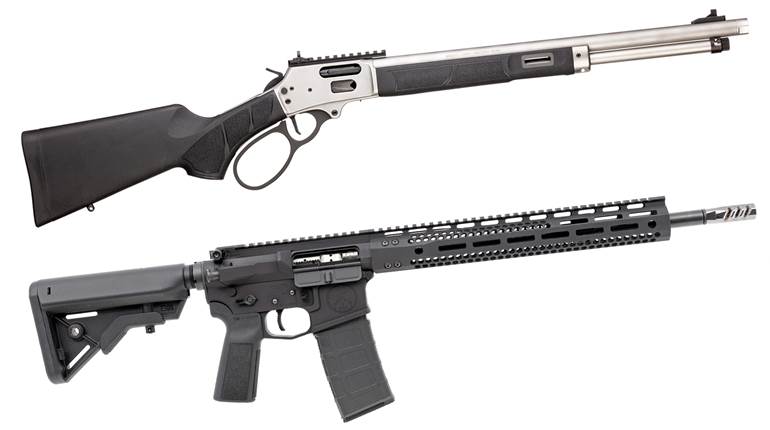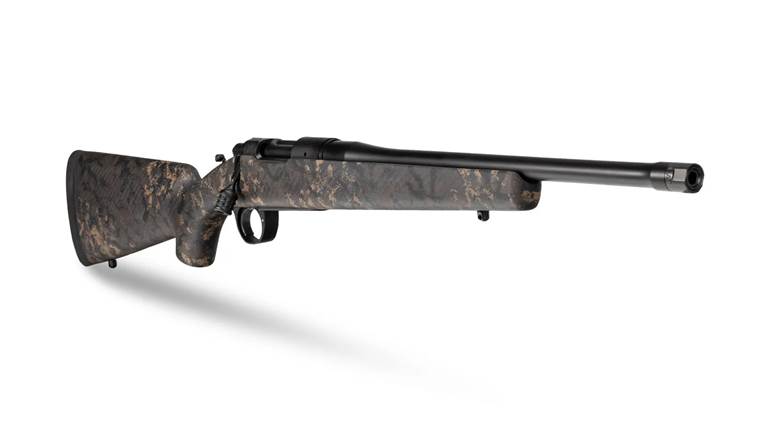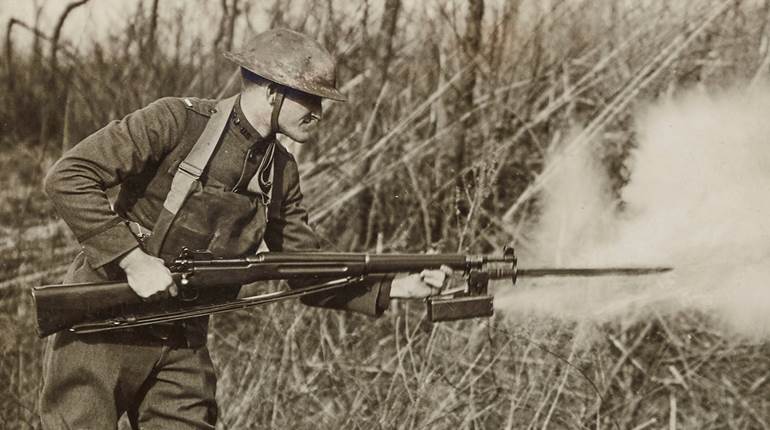
When the United States entered the woefully misnamed “War to End All Wars” on April 6, 1917, the nation was immediately faced with a serious shortage of service rifles. The government had approximately 600,000 Model 1903 Springfields on hand along with some 160,000 obsolescent Krags, numbers totally insufficient to meet the projected demand. Production of the standardized Model 1903 rifle was ordered to be increased at both Springfield Armory and Rock Island Arsenal. The U.S. Ordnance Dept. consulted with Springfield and Rock Island engineers for ways to reduce production time and cost for ’03 manufacture but, without a substantial redesign, changes would only be cosmetic. It was apparent that the combined output of these two national arsenals could not meet demand, and large numbers of additional service rifles would soon be needed.
The Ordnance Dept. had two options for procuring additional rifles: Seek additional manufacturing sources for the Model 1903 or adopt a second service rifle to augment the ’03. The former was explored at length, but the lag time required to find suitable firms capable and willing to manufacture the ’03 rifle, negotiate contracts, procure the necessary materials and machinery, then train workforces would be too great to alleviate the potential crippling shortage of rifles within a reasonable period of time. Thus, almost by default, the Ordnance Dept. was left with looking at another rifle as the only viable alternative.
Sometimes, timing is everything, and it was fortuitous that at the time the United States declared war, three American plants were completing production of large numbers of the “Pattern 1914” rifles under contract for Great Britain. The .303 British Pattern 1914 rifle was a slight modification of the “Enfield .276-inch Magazine Rifle,” also known as the “Pattern 1913,” which was a modified Mauser design chambered for an advanced .276-cal. cartridge. The workforces and production machinery used to manufacture the Pattern 1914 were still in place, thus the firms could almost immediately go into production for the U.S. government. The manufacturers were: Winchester Repeating Arms Co., New Haven, Conn.; Remington Arms Company, Ilion, N.Y.; and Eddystone Rifle Plant, operated by Midvale Steel & Ordnance Co., an affiliate of Remington located in Eddystone, Pa.
Assistant Secretary of War Benedict Crowell later said that three large plants with trained workers and tooling intact at the right time to manufacture critically needed rifles was “…well nigh providential.” While it was unquestionably fortunate to have these production facilities on hand, the Ordnance Dept. was faced with yet another dilemma. If the three plants converted from Pattern 1914 to M1903 production, troops would be issued the familiar ’03, but it would require an inordinate—and unacceptable—length of time to get a totally new rifle into production at three different factories.
The Ordnance Dept. also looked at adopting the Pattern 1914 in the .303 British chambering, permitting the maximum number of rifles to be manufactured in the least amount of time. But this would introduce a non-standard cartridge—one generally viewed as inferior to .30-’06 Sprg.—and add likely troublesome supply problems. Finally, the Pattern 1914 could be modified to accept the .30-’06 Sprg., which would reduce supply issues, but would cause some delay in getting the modified rifle into production.
After studying the options, American ordnance engineers were put to work modifying the British rifle to accept the U.S. service cartridge, and the result was adopted as “United States Rifle, Caliber .30, Model of 1917.” The American government was criticized by some for delaying the acquisition of additional rifles but, in retrospect, this was clearly the most logical choice. In 1919, a report issued by Assistant Secretary of War Crowell stated: “The decision to modify the Enfield was one of the great decisions of the executive prosecution of the war—all honor to the men who made it.”
In addition to the production delays, there was some resistance to the new rifle itself, as well as some misconceptions regarding its suitably for the American armed forces. An article in the widely-read "New York Sun" about the newly adopted rifle was entitled “Why our forces in France must use an inferior rifle,” and it cited a number of “facts” that were either misleading or outright falsehoods. Interestingly, this article appeared before any M1917 rifles had even been issued to American troops. A subsequent July 28, 1917, article in American Rifleman’s predecessor, Arms & the Man, soundly refuted the previous newspaper piece and gave logical reasons for the adoption of the M1917 as a supplement to the Model 1903 Springfield.
From a technical standpoint, converting the Pattern 1914 rifle to chamber .30-’06 Sprg. was not particularly difficult. The M1917 possessed a strong, nickel-steel action that could handle the pressures of .30-’06 Sprg. with no problems. The fact that the Pattern 1914’s predecessor, the Pattern 1913 rifle, was originally designed for use with a rimless cartridge (the .276) actually made the M1917 more suited to the rimless .30-’06 Sprg. than the rimmed .303 British round.
On May 10, 1917, each of the three manufacturers sent Springfield Armory a sample M1917 for evaluation and testing. Most of the parts were hand-fitted, resulting in a lack of interchangeability among many of the components. This presented the Ordnance Dept. with yet another dilemma. Obviously, total interchangeability of parts was desirable, but to totally rectify the situation would require a significant delay in getting the critically needed guns into mass production. Despite the pressing demand, it was decided to postpone so engineers at the three factories, assisted by the Ordnance Dept., could reduce or eliminate the interchangeability issue. On July 12, 1917, each contractor submitted a second sample that reflected some improvement, but component interchangeability was still judged to be less than satisfactory. The Ordnance Dept. gave each maker the option of immediately proceeding with mass production and working on the interchangeability problems during the course of manufacture, or waiting until completion of standardized manufacturing drawings. Remington and Eddystone delayed production until the drawings could be obtained, but Winchester proceeded with M1917 manufacture. Assistant Secretary of War Crowell later commented, “It would have been well if the same course (waiting for final specifications) had been followed at the Winchester plant, for word came later from Europe not to send over any rifles of Winchester manufacture during that period.”
Eventually standardized manufacturing specifications and drawings were finalized, and large numbers of Model 1917s began to flow from all three plants. While the interchangeability problem was never totally eliminated, a 95 percent interchangeability rate was established, which was acceptable to the Ordnance Dept. Eventually the interchangeability problems with early production Winchesters were eliminated, and later rifles were equal in all aspects to the Remingtons and Eddystones.
The U.S. M1917 was 46.3" in overall length with a 26-inch barrel. It weighed 8 pounds, 3 ounces, and had a magazine capacity of six rounds. The same type of five-round charger (i.e. “stripper clip”) used with the ’03 rifle was also used with the M1917. This resulted in five rounds being routinely carried in the magazine, although a sixth cartridge could easily be manually inserted. The rear sight had a folding leaf adjustable for elevation, but not windage. The sight was mounted on the rear of the receiver which made it a better battle sight than the ’03’s barrel-mounted Model 1905 rear sight. The front sight blade was protected by two sturdy “ears,” one on either side. The stock and two-piece handguard were made of oil-finished black walnut with grasping grooves milled into both sides of the fore-end. Most of the external metal parts were blued, except for late production Eddystones, which were factory Parkerized beginning around October or November 1918. After the war, the vast majority of Model 1917 rifles were overhauled, which typically resulted in the formerly blued rifles being Parkerized as part of the rebuild procedure.
Another distinctive feature of the design was a “crooked” bolt handle intended to bring the shooter’s finger in close proximity to the trigger. Although clearly a bit hyperbolic, a post-World War I War Department report stated, “… by bending back the bolt handle we had placed two men on the firing line where there was only one before.”
The receiver ring of the rifle was stamped “U.S./Model of 1917”/(name of maker)/serial number. The barrel was stamped on top (behind the front sight) with the initials of the maker (“W,” “R,” or “E”), a “flaming bomb” insignia and the month and year of production. The receiver rings of very early Winchesters were simply marked “W”—as was the case with the British Pattern 1914 rifles—in addition to the serial number and “U.S.” Only the first few thousand Winchester M1917s were marked in this manner and the vast majority had “Winchester” stamped on the receiver ring. Serial numbers were sequentially applied beginning with “1.” A number of other parts were also marked with the initial of the manufacturer. The M1917 bayonet was adopted concurrently with the M1917 rifle, and it was a copy of the British Pattern 1914 bayonet. In fact, some bayonets made for the Pattern 1914 had the British property stamps obliterated and over-stamped with U.S. military markings.
Given a choice, the average Doughboy would have probably preferred an M1903 Springfield to an M1917 due to the former’s lighter weight and better handling characteristics. There were also several features of the British rifle that some American soldiers found, at least initially, to be somewhat objectionable. For example, the M1917 has a cock-on-closing action, while the ’03 cocked on opening. This resulted in many complaints against the M1917’s operation, primarily due to lack of familiarity. Also, the M1917 did not have a magazine cut-off, which meant that the follower blocked the closing of the bolt when the magazine was empty. This often caused some consternation and awkwardness during close order drill. Some soldiers reportedly inserted a dime to keep the follower from blocking the bolt but this was hardly a suitable fix. Eventually, a stamped sheet metal “magazine platform depressor” was issued.
Nevertheless, the M1917 eventually won over many of its former critics as it proved itself to be a sturdy and reliable infantry rifle with an excellent battle sight. The rifle acquitted itself very well on the battlefields of France and, as they gained experience with M1917s, fewer soldiers complained about having to use an “American Enfield” rather than a Springfield. There were many reports regarding the efficacy of the new rifle, and relatively few detailed any significant problems.
By the time of the Armistice, some 1,123,259 M1917s had been shipped to France; 800,967 issued to troops and 322,292 “ … floated in bulk” (unissued in reserve). Of this figure, 61,000 were reportedly issued to the U.S. Marine Corps and 604 to the U.S. Navy. In addition, 127,000 M1917 rifles had been issued to U.S. military personnel still in the United States and another 70,940 were on hand at various ordnance facilities and military installations. These figures represent substantially fewer than the more than 2 million M1917s eventually manufactured, as manufacture continued after the Armistice but prior to cancellation of the production contracts. By the time of the Armistice, an estimated 75 percent of the American Expeditionary Force (AEF) was armed with the “American Enfield.”
After World War I, the ’03 Springfield remained the standardized U.S. military service rifle, even though there were larger numbers of Model 1917 in inventory. Some Model 1917s were called back into service during World War II as training and supplemental service rifles, but the “American Enfield’s” glory days were all too brief, and they ended with the Armistice.





































